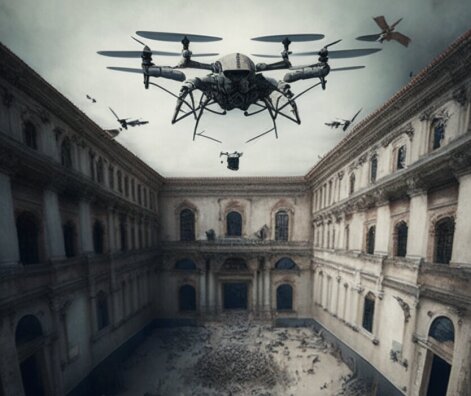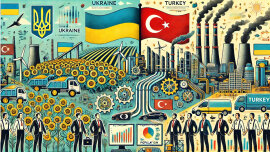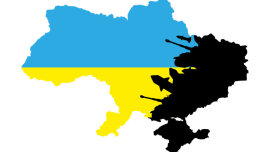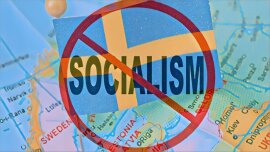For more than a month now, social networks have been seething with the finds of enthusiastic researchers who discover more and more mysterious, inexplicable or simply impudent cost items of the central and local budgets during the war. Society's opinions range from "prohibit any expenditures other than military ones" to "what do you care - these funds are allocated specifically for improvement (roads, books, etc.)." The latest masterpiece of budget lawmaking was the allocation of UAH 573 million for the construction “on the anniversary” of the second stage of the Holodomor Museum in the center of Kiev (despite the fact that the first stage already exists there, which has been successfully funded for almost 20 years). Let's try to figure out who is right by bracketing emotions and using one of the basic laws of economics: the law of alternative possibilities, or "Guns against butter."
I must say right away that in the conditions of modern Ukraine one should not take the historical name of the law literally, because we still have enough butter. Although the name appeared for a reason, and at one time (the first half of the 20th century), it was quite specific.
But still, let's get back to the theory that economics students study in their first year.
Axiom. Production possibilities are limited
Everyone would like to see all the benefits (goods and services) produced within the country, which would be enough to meet all needs, both civilian and military. However, no country (and even the world economy as a whole) has such limitless resources to cover such needs. Therefore, when determining the policy for the production of certain goods, one always has to choose. For example, if we spend the entire resource of the cement industry on fortifications (and there is a lot of cement needed), then it will not be enough for road and civil construction, and there will simply not be enough left to repair your dacha either. And vice versa, having spent all the cement on new interchange bridges and monumental structures, we will not be able to build pillboxes at the front and bring the workshops for the production of weapons into working condition. Therefore, we need to choose for our current situation a point on the production possibilities curve that will allow us to cover both most of the needs of the army and the critical needs of the civilian sector. But only critical ones, otherwise there will not be enough resources, because cement from America will be too expensive and you will have to pay for it in the currency that Ukraine already borrows.
Alternative opportunities for butter and gun production
|
Option |
Oil, million tons |
Guns, thousand pieces |
|
A |
0 |
30 |
|
IN |
2 |
27 |
|
WITH |
4 |
21 |
|
D |
6 |
12 |
|
E |
8 |
0 |
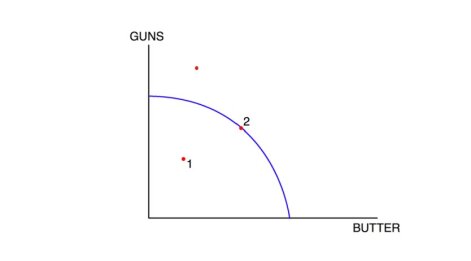
Let's examine the chart:
If the economy is at point 1, this means that the available resources are not fully used: there is an opportunity to increase the production of both guns and butter. Point 1 indicates underproduction and inefficient use of resources.
The point above the graph with given resources and available technology for production is unattainable. But this does not mean at all that production possibilities cannot increase. There are two ways to expand production capabilities:
- extensive - carried out by involving additional resources (increase in the number of employees, involvement in the processing of new reserves of natural raw materials, growth in investment without changing the technical basis of production);
- intensive - achieved through better use of available resources (acceleration of scientific and technical progress and, on this basis, an increase in the productivity of labor and equipment, an improvement in the organization of production, etc.).
Any production is efficient if it ensures the full use of resources, i.e. if an increase in the production of one product leads to a decrease in the production of another product. Therefore, any point lying on the curve (point 2) of production possibilities is efficient.
Since an increase in the production of one product leads to a reduction in the production of another, the cost of producing one product can be expressed in terms of the amount of another product, the production of which has to be abandoned in connection with the production of the first. So, in the table we see that the increase in oil production from zero to 2 million tons "cost" 3 thousand guns, the production of which had to be abandoned. We can say that an additional 2 million tons of oil cost 3 thousand guns. In economics, such a cost or such cost of production is called opportunity or imputed.
Opportunity cost: What you have to give up to get what you want. It is not for nothing that the opportunity cost is often referred to as the opportunity cost.
Consider a historical example: In the USSR on the eve of the Great Patriotic War (1941-1945) there was full employment, all labor resources were fully used, there was no unemployment. When the war began, it was possible to increase the production of military products only by reducing the production of civilian products. In the United States before the war (1939), labor resources were underutilized, and unemployment reached 17.2%. When the Second World War began, the US was able to increase the production of both military and civilian products. By 1944, unemployment had fallen to 1.2%. Thus, the USA moved in the direction of intensification - from point 1 to point 2, using the available labor resource (and achieved excellent results), and the USSR, moving point 2 upwards along the curve of guns and oil,
What and how can Ukraine use today?
- labor resources are in short supply (especially qualified engineers and machine-builders), because people are either already employed in the military sphere or have left;
- natural resources: land, water, minerals, we certainly have, and industrial sites with workshops are generally in abundance, but they alone are not enough for the production of modern high-tech military products. You need imported components and technologies, and you need currency to purchase them. But the same resources (and currency) are also needed for civilian production, incl. capital construction, where Ukraine not only cannot cover its own needs, but is even forced to buy Russian goods on the black market, bypassing its own sanctions.
Can we say that production in Ukraine is efficient? No and no. Now it is closer to point 1, or rather, between 1 and the starting point, for a number of reasons: from interruptions in the supply of imported resources to the human factor - bungling, tax terror, stupid management in the public sector and the absence of a normal procurement system for the private sector. All these reasons are discussed in detail in the articles by Pavel Vernivsky, Alexey Kushch and other authors.
In conditions when a significant part of the resource is distributed by the state, its redirection from military tasks (which today determine the survival of the people and the state) to civilian ones requires a very balanced approach, which is based on the understanding that the cornucopia does not exist, even if it means Western assistance. And the point on our chart should definitely be shifted towards the guns. Of course, it is also irrational, and physically impossible, to completely withdraw goods, finances and people for war - the production (import) of food and other consumer goods will stop (we will remain without butter) and in general the entire economic mechanism. This was not done either in the USSR or in Great Britain during the Second World War, although the situation was very difficult. But you need to work both in the direction of increasing the intensity (shifting point 1 to point 2) and in the direction of providing the main need of the day: defense. Because every conditional millimeter on this graph is people's lives.
As an example, today many authors often use the approximate number of drones that could be produced as an alternative to budget projects such as building museums. And it is right. This is what the alternative looks like in our current reality. Today is the time of drones, not museums.
Thank the author: 5363 5420 9874 3496 Privatbank.
Frequently asked questions/comments on a topic that you want to answer right away.
1. And I want everything at once
Will not work. Because the physical resources and energy of society cannot be scattered in several directions at once. To achieve the result, a concentration of efforts is needed, which on the graph will look like the transition of the economy to point 2 and its upward shift.
2. Why did Israel succeed?
Israel's most dangerous war for the existence of the country (the Doomsday War of 1973) lasted 17 days. Israel had to mobilize about 14% of the population (if Ukraine had mobilized that much, the army would now have 4.2 ml of people) and all available production resources. Before that, there was a 6-day war in 1967. Did anyone think about any alternatives these days? I highly doubt it. The Yad Vashem Museum was built in 1953-57, during a relatively quiet period when it was possible to take on civic projects. In addition, it is not customary in Israel to split society during the war, appoint internal enemies, steal billions and play other much-loved games of Ukrainians.
3. And sponsors paid for us
It doesn't matter who paid the costs. One way or another, to implement the project, it is necessary to purchase resources not only on the domestic market (for hryvnias), but also on the external market (for the currency that we received on credit). In addition, some resources are valuable and irreplaceable.
4. Let's just print more money and build whatever we want
For printed hryvnias, Ukraine now can only afford to dig a pit or build a mound, and manually with shovels, because all the excavators at construction sites are Chinese. From the materials we have sand, cement and other relatively cheap resources, all industrial products (and it makes up to 80% of the construction estimate) and other resources for any project will also have to be bought abroad, and this requires a currency that, much more rationally, is now used to purchase weapons, equipment and components for its production.
5. Culture will disappear without an urgent injection of money.
If the war is lost, then the culture in its present form will definitely disappear. And now the budgetary and cultural sector (the private sector in culture was practically destroyed even during quarantine) should be focused on the tasks of supporting the mental health of the population sitting under shelling, low-budget cultural diplomacy projects to convey the Ukrainian position abroad, and similar tasks. This does not require any additional injections, the salary is already accrued within the budget. But not in any way on major repairs, new construction, filming of serials, billion-dollar purchases of books, etc.
6. Symbols are so important that you can redirect part of the resource to them.
Spending millions on mega-flagpoles, stainless tridents and other elements of self-expression of city mayors has long been not pleasing, but rather causes irritation and anger in people. If symbols are important to you personally, buy a patriotic T-shirt and wear it to your health. I would nail a price plate under each such flagpole. Only not in money, but in lives.
7. What do you offer?
Everything has already been proposed. The main points of the bill on the military economy, which had to be adopted on the first day after the occupation of Crimea, were written and sent to the deputies. A number of very competent experts have been developing in detail the solution to the dilemma of guns and butter since 2014, including tax policy, the policy of forming the central and local budgets, etc. But no one hears them, the machine for counting bills rustles too loudly.
